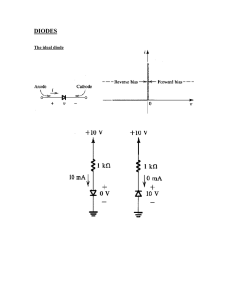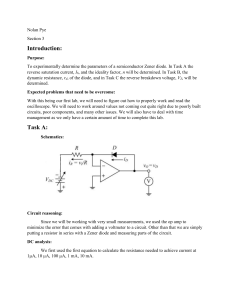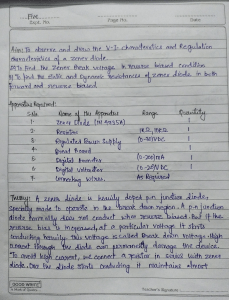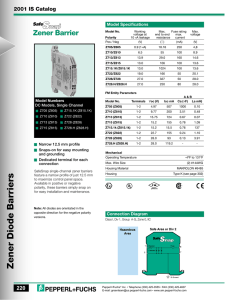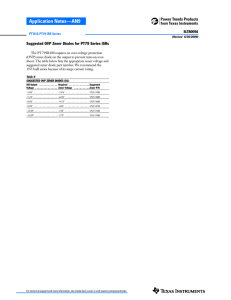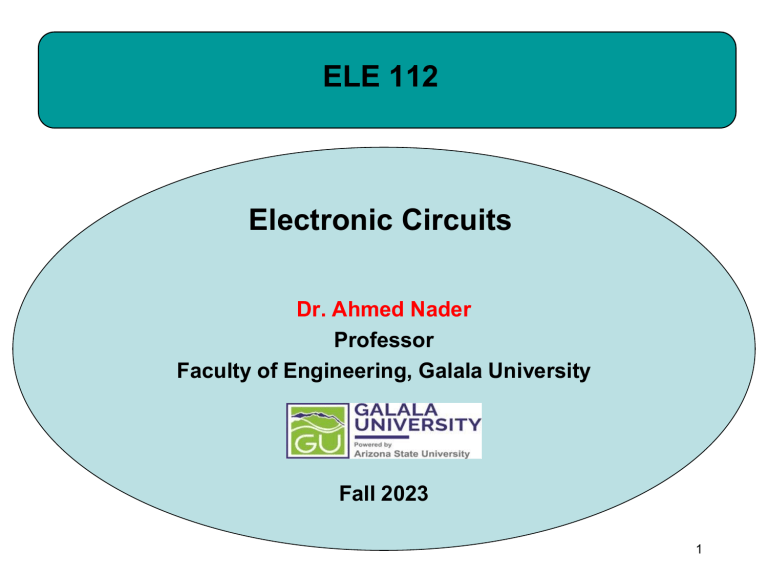
ELE 112 Electronic Circuits Dr. Ahmed Nader Professor Faculty of Engineering, Galala University Fall 2023 1 Because learning changes everything. ® Chapter 5 Special-Purpose Diodes Electronic Principles Ninth Edition Albert Malvino, David J. Bates, Patrick E. Hoppe © 2021 McGraw-Hill. All rights reserved. Authorized only for instructor use in the classroom. No reproduction or further distribution permitted without the prior written consent of McGraw-Hill. Topics Covered in Chapter 5 • • • • • • • Zener Diodes. Light-Emitting Diodes. 7 Segment Displays. Photodiodes & Optocouplers. Schottky Diodes. Varactor. Special Purpose Diodes. © McGraw-Hill 3 Zener Diode 1 • Zener diodes are designed and optimized to operate in their “breakdown” region (very sharp knee). Zener diodes are “reverse biased.” • A common use for zener diodes is voltage regulation (it maintains a constant output voltage even though the Forward Reverse current through it changes). Breakdown © McGraw-Hill 4 Power Supply • Power Supplies combine multiple stages. • Step-Up. • Step-Down. • Isolation. © McGraw-Hill • Half-Wave. • Full-Wave. • Bridge. • Choke-Input. • CapacitorInput. • Integrated Circuit. • Discrete Parts. 5 Zener Effect • When a diode is heavily doped, the depletion layer becomes very narrow. Because of this, the electric field (= voltage/distance) is very intense. When the field strength is intense enough, it will pull electrons out of their valence orbits. The creation of free electrons in this way is called Zener effect. • Different than avalanche effect where the minority carriers are accelerated to high enough speeds to dislodge other minority carriers, producing a chain effect that results in a large reverse current. © McGraw-Hill 6 Zener Diode 2 • To get breakdown operation, the source voltage VS must be greater than the Zener breakdown voltage VZ. • A series resistor R1 is always used to limit the Zener current to less than its maximum current rating. © McGraw-Hill 7 Zener Diode 3 VS VR1 VZ 0 VR1 VS VZ VR1 7 V VR1 I R1 R1 Find IR1?? I R1 7 mA Zener diodes are typically labeled D1, D2, etc. The label of VZ was used to emphasize the fixed voltage drop across the zener diode. © McGraw-Hill 8 Zener Diode 4 Ammeter Voltmeter What happens if Vs changes from 20V to 30V? © McGraw-Hill 9 Load Lines 1 • The Q point is where the circuit is operating, based on the voltage source. • The Q point is the intersection of the load line and the Zener diode V-I curve. • When the source voltage changes, a different load line appears with a different Q point. © McGraw-Hill 10 Load Lines 2 VS VZ IZ RS 20V 1kΩ Calculating the ends of the load line. © McGraw-Hill VS 20 V 30 V IZ (diode shorted) 20 mA 30 mA VZ (diode open) 20 V 30 V 11 Zener Diode With RL 𝑽𝑳 𝑽𝒁 𝑰𝑳 = = 𝑹𝑳 𝑹𝑳 𝑉𝑇𝐻 1𝑘 = 𝑉𝑆 1𝑘 + 1𝑘 𝑉𝑇𝐻 = 15𝑉 VTH VZ This circuit will function properly (Zener diode regulates) if the zener diode “sees” a VTH greater than the Zener voltage rating. VTH © McGraw-Hill RL VS R1 RL 𝑽𝑺 − 𝑽𝒁 𝑰𝑺 = 𝑹𝟏 Should be > 0 for proper regulation 12 Example © McGraw-Hill 13 Temperature Coefficient • When the ambient temperature changes, VZ will change slightly. The temperature coefficient is defined as the change in breakdown voltage per degree of increase. Example: A Zener diode with a breakdown voltage of 4 V may have a temperature coefficient of -2 mV/°C. If temperature increases by 1°, the breakdown voltage decreases by 2 mV. • In applications requiring a highly stable reference voltage, a Zener diode is connected in series with one or more semiconductor diodes whose voltage drops change with temperature in the opposite direction that VZ changes. © McGraw-Hill 14 2nd Approx. of a Zener Diode The zener resistance ( RZ ) is typically very small and has a minor effect on the load voltage. © McGraw-Hill 15 Zener Diode 6 Once the Zener diode is conducting, continue increasing the voltage source. Measure the diode current and voltage at two distinct voltage source values. V2 V1 RZ I 2 I1 © McGraw-Hill 16 Zener Diode 7 V1 10 V I D1 20.24 mA VD1 6.25 V V1 12 V I D1 30.47 mA VD1 6.27 V 6.27 V 6.25 V RZ 30.47 mA 20.24 mA © McGraw-Hill RZ 1.96Ω 17 2nd Approx. of a Zener Diode 2 Given: I Z 10 mA RZ 10Ω VL VZ I Z RZ Where VL I Z RZ VL (10mA)(10Ω) VL 100 mV © McGraw-Hill 18 Output Ripples © McGraw-Hill 19 Examples Solution: © McGraw-Hill 20 Zener Diode Ratings • Maximum power PZ max VZ I Z ( max ) . (safety factor of 2) • Available tolerances (VZ): 1, 2, 5 and 20 percent. • Zener resistance, RZT , increases at the knee of the characteristic curve. • A derating factor: how much you have to reduce the power rating of a device. For example, 6.67 mW per degree for temperatures above 50 °C is typical. © McGraw-Hill 21 Other Applications Pre-regulator (1st Zener) • Explain the operation of the above circuits. © McGraw-Hill 22 Optoelectronics • Optoelectronics is the technology that combines optics and electronics. This field includes many devices based on the action of a pn junction. • Examples of optoelectronic devices are: 1) LED (Current Light) 2) Photodiodes (Light Current) 3) Optocouplers 4) Laser diodes © McGraw-Hill 23 Light-Emitting Diodes 1 • LEDs have replaced incandescent lamps in many applications because of: lower energy consumption (efficiency) and longer lifetime. • The material used for the semiconductor die will determine the LED’s characteristics. © McGraw-Hill 24 Energy Levels 1 • Each radius equals an energy level. The lowest energy level is in the smallest orbit. The highest energy level is in the largest orbit. • When an electron is moved from a lower to a higher orbit, it gains potential energy with respect to the nucleus. Outside energy is required to lift an electron to an outer orbit. Sources of outside energy are: heat, light, and voltage. © McGraw-Hill 25 Energy Levels 2 • When an electron falls back to a smaller orbit, it gives up the extra energy in the form of heat, light, or other radiation. Free electron Recombination Valence electron Exit © McGraw-Hill 26 Light-Emitting Diodes 2 • In a forward-biased diode, free electrons cross the pn junction and fall into holes. Falling from a higher to a lower energy level, they radiate energy in the form of light. • LEDs have very low reverse bias voltage limit Typical peak inverse voltage (PIV) is 5V. © McGraw-Hill 27 Light-Emitting Diodes 3 • The shorter lead is the Cathode. • The flat side is the Cathode. • Visible (red, etc.) or Infrared Light • The color of the light, which corresponds to the wavelength energy of the photons, is primarily determined by the energy band gap of the semiconductor materials that are used. © McGraw-Hill 28 Light-Emitting Diodes 4 • The typical forward voltage drop for LEDs is between 1.5 V and 2.5 V. • The brightness of a LED depends on the current. The amount of light emitted is often specified as its luminous intensity and is rated in candelas (cd) for example 70mcd at 20mA. VS VD IS ID RS PD VD I D © McGraw-Hill 29 Light-Emitting Diodes Solve for VRS , I D1 , and PD1 5 VS VRS VD1 0 VRS VS VD1 VRS 12 V 2 V VRS 10 V 10V VRS I RS I RS 1kΩ RS Note: Since the forward voltage range for VD1 is 1.5 V to 2.5 V, we use 2 V. © McGraw-Hill PD1 20 mW 30 Applications © McGraw-Hill 1 31 Applications • 2 What is the purpose of the capacitor? Same as resistor but with average power dissipation = ?? • What is the purpose of the diode? Provide a path during the negative half cycle © McGraw-Hill 32 7 Segment Display 1 • Seven-segment displays are LEDs arranged in a pattern to display decimal numbers. • The LEDs are labeled A through G. © McGraw-Hill 33 7 Segment Display 2 • The LEDs share either a Common Anode (CA) or a Common Cathode (CC). • Common Anode Design: Single (common) power connection and multiple ground connections. © McGraw-Hill 34 7 Segment Display 3 • Common Cathode Design: Single (common) ground connection and multiple “high” connections. © McGraw-Hill 35 Light-Emitting Diodes 6 High-power LEDs are now available with continuous power ratings of 10 W and above. These power LEDs can operate in the hundreds of mAs to over 1 A of current. An increasing array of applications are being developed including automotive interior and exterior lighting, architectural indoor and outdoor area lighting. luminous intensity 𝐄𝐟𝐟𝐢𝐜𝐢𝐞𝐧𝐜𝐲 = 𝐏𝐨𝐰𝐞𝐫 © McGraw-Hill 36 Photodiodes When light energy bombards a pn junction, it can dislodge valence electrons (like thermal energy). The incoming light produces free electrons and holes. The stronger the light, the greater number of minority carriers. The more light striking the junction, the larger the reverse current in a diode. A photodiode has been optimized for its sensitivity to light (the reverse current is in range of 10μA). Used in digital cameras. © McGraw-Hill 37 Optocouplers • An optocoupler is formed when a LED and a Photodiode are used together. • When input voltage is varying, amount of light is fluctuating. Thus, output voltage is varying. • Provides electrical isolation between the input and output circuits. © McGraw-Hill 38 Remote Control 39 Schottky Diode 1 • The Schottky diode is used for high frequency rectification (>300 MHz), where fast switching times are required. Common diodes used in HF rectification produce reverse conduction called “tails.” • The Schottky diode has very small reverse recovery time tr: The time it takes to turn off a forward-biased diode (recombination of stored charges). © McGraw-Hill 40 Schottky Diode 2 • Uses a metal such as gold, silver, or platinum on one side of the junction (no holes) and doped silicon (typically n-type) on the other side. • It has no depletion layer no stored charges at junction and no reverse recovery time. • The Schottky diode has a barrier potential of only 0.25 V. It has low PIV, typically 50 V or less • A majority carrier device • No recombination occurs © McGraw-Hill 41 Various Special Purpose Diodes 1 Varactor (Variable Capacitor) Diode • • • • Used in reverse bias Exhibits variable capacitance. Used to tune resonant circuits. Applications include radio and television tuners. A parallel LC tank circuit has only one frequency at which maximum impedance occurs (resonance). 𝐶𝑇 = 𝐶𝑗0 1+ © McGraw-Hill 𝑉𝑅 2∅𝐹 42 Bandpass Filter • The RLC series resonant circuit provides a bandpass filter when the output is taken off the resistor. • The center frequency is: 0 1 LC • The filter will pass frequencies from 𝜔1 𝑡𝑜 𝜔2 • It can also be made by feeding the output from a lowpass to a highpass filter. © McGraw Hill 43 Various Special Purpose Diodes Laser: Emits coherent light. 2 intrinsic • Used for burning data in DVD players. PIN: Operates as a variable resistor at RF and microwave frequencies. Step-recovery: Snaps off when reverse biased. • Frequency multipliers. Back: Conducts better when reverse biased. • Small-signal rectifiers. Tunnel: Has a negative resistance region. • Used in high-frequency oscillators. © McGraw-Hill 44 Summary © McGraw-Hill 45 Important Formulas VZ VL 1st Approx. 1 VS VZ IS RS VL IL RL IZ IS IL 2nd Approx. © McGraw-Hill VL VZ VL VL I Z RZ 46
